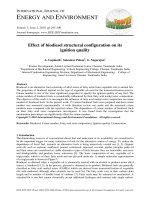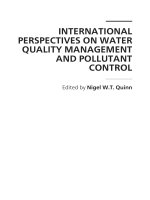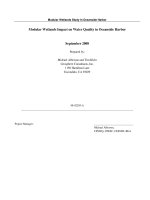Effect of canals on water quality of Saigon river – sections flow through Binh Duong province
Bạn đang xem bản rút gọn của tài liệu. Xem và tải ngay bản đầy đủ của tài liệu tại đây (614.02 KB, 7 trang )
Nguyen Hien Than...
Effect of canals to water quality of Saigon river...
EFFECT OF CANALS ON WATER QUALITY OF SAIGON
RIVER – SECTIONS FLOW THROUGH BINH DUONG PROVINCE
Nguyen Hien Than1, Truong Quoc Minh1
1
Thu Dau Mot University
ARTICLE INFO
Article history: Received Dec. 24.2018, Accepted Feb. 10.2019.
Contact:
Abstract
Saigon River is a major river system and plays an important role in the economic and social
development of the Southern key economic region. This paper studies the relationship between canals
and the Saigon River. Water quality monitoring data was collected at the Department of Natural
Resources and Environment, with 10 parameters (temperature, pH, DO, turbidity, TSS, COD, BOD5, NNH4, P-PO4, coliform) calculated in the period 2007-2016. The results showed that the Saigon River’s
water quality has been good and stable water quality in recent years, fluctuating around the level of 80 used for domestic water supply after appropriate measures have been taken. The water quality in canals
flowing into the Saigon River was relatively stable and was at the medium level over years. It is used for
irrigation purposes and other similar purposes. The results of the correlation analysis also showed that
the RSG1 (at Ba Sang Bridge), RSG2 (Suoi Giua at Suoi Giua Bridge) and RSG6 (Rach Vinh Binh at
Din Ky Restaurant) were fair correlated with Saigon river’s water quality with the correlation
coefficient of 0.3995, 0.4280 and 0.3351 respectively. These results indicated that the monitoring points
at Ba Sang Bridge and Suoi Giua at Suoi Giua Bridge and Vinh Binh Canal at Din Ky restaurant
affected the Sai Gon river’s water quality in the area flowing Binh Duong province.
Keywords: Binh Duong, Saigon river, water quality
INTRODUCTION
Binh Duong is one of the dynamic localities in the economy. By November 30, 2017,
domestic investment attracted VND 44,046 billion (up 51.4%); Up to now, the province has 30,571
enterprises registered business, total registered capital VND 234.722 billion. Foreign direct
investment reached 2.557 billion US dollars, surpassing 82.6% of the year plan; Up to now, the
province has 3,034 foreign-invested projects with a total registered capital of 28.33 billion US
dollars (Binh Duong Provincial Statistics Office, 2017).
Along with the development of the industry, the environmental quality in the area is reduced
significantly. Household effluent is discharged directly into canals, ponds, rivers, streams,
pesticides of farmer households following rainwater flow to nearby water sources, waste disposed
of canals. Water from these canals follows the flow to the Sai Gon River system in Binh Duong
province, which pollutes river water and affects people's life and health.
70
Thu Dau Mot University Journal of Science
Issue 1(40)-2019
Therefore, protecting the environment of the Saigon River is an urgent and important
concern. In order to have a good source of information to serve the environmental protection of the
Saigon River, the water monitoring network has become more and more widespread. Water
monitoring data from monitoring programs are often used in environmental status reports of the
Saigon River. Parameters in the water environment are analyzed and assessed for state and status of
water quality. From there, the assessment of river water quality to give accurate results on the
situation and the main causes affecting water quality is important. Currently, the research of water
quality in Binh Duong province has many projects such as:
The research project of Nguyen Hien Than with the title "Assessment about the relationship
between economic growth and environmental quality in Binh Duong province" (Nguyen Hien Than,
2013). In this study, the author has used the WQI index to assess the water quality of Binh Duong
province.
Cao Thi Thuy Tien with the title "Research on sustainable solutions to manage surface water
resources and serve the urban environment and industrial zones in Binh Duong province up to
2020" (Cao Thi Thuy Tien, 2011). In this study, the author has used the WQI weight to assess the
water quality of Binh Duong province.
Nguyen Thi Kim Yen (2009) with the topic "Research and assessment of water quality in the
Thi Tinh River basin under the impacts of the socio-economic development process in Binh Duong
province".
In addition, Huynh Thi Nhu Quynh (2008) with the topic "Assessment of water quality by
WQI index and proposed solutions for environmental protection of surface water in Binh Duong
province ".
In general, there have been many studies to evaluate the quality of river water environment in
the province of Binh Duong by WQI method, but there have been no studies on the impact of the
canal systems on the water quality of the Saigon river – sections flow through Binh Duong
province. In order to contribute to the environmental protection of the Saigon River in Binh Duong
Province, the author conducts research on the impact of canals on the water quality of Saigon River.
The result of this study will provide quantitative information on pollution levels and impacts of
canals to the Saigon River from which to devise pollution mitigation measures and water quality
management plans.
MATERIALS AND METHODS
Materials
Data were collected from environmental monitoring data in Binh Duong province from 2007
to 2016. The monitoring points consisted of 03 monitoring points on the Saigon River: 2 km from
Dau Tieng dam (point SG1), water intake Thu Dau Mot water plant (point SG2), 50m from the
Vinh Binh canal - Saigon River junction downstream to the lower section (point SG3); Eleven
monitoring points at canals: Ba Sang Bridge (point RSG1), Suoi Giua Bridge (point RSG2), Ong
Danh Canal at Ong Danh Bridge (point RSG3), Suoi Cat (point RSG4), Chom Sao Stream (point
RSG5), Vinh Binh canal (point RSG6), Ba Bo canal (point RSG7), the drainage canal of An Tay
71
Nguyen Hien Than...
Effect of canals to water quality of Saigon river...
(point RSG8), the drainage canal of the Ong Bo bridge (point RSG9), D canal (point RSG10), Don
stream (point RSG11).
Methods
Water quality index method
The Water Quality Index is an index calculated from the Water Quality monitoring
parameters used to quantify the water quality and its utilization; performed on a scale.
Where, WQIa: The calculated WQI value for the parameters: DO, NH3, COD; WQIb: The
calculated WQI value for two parameters: TSS, Turbidity; WQIc: The calculated WQI value for Total
coliform; WQIpH: The calculated WQI value for pH (General Department of Environment, 2011).
Statistical analysis method
Method of regression analysis – correlation: modeling (or Equation) regression and defining
properties (reciprocal) as well as the form of relationship (type of model)
Canonical Correspondence Analysis (CCA) is a multivariate analysis method developed by
Braak (1986). In this study, CCA is used to identify and measure the relationship between two
variables. Variable X is the water quality of the canals that flow into the Saigon River (consist of
RSG1, RSG2, RSG3, RSG4, RSG5, RSG6 và RSG7) and variable Y is the water quality of Sai Gon
river (consist of SG1, SG2 and SG3). This method will develop a model showing which monitoring
points are related to the points: SG1, SG2 and SG3 and these points are not related.
In this study, using SPSS software to model a regression – correlation of the parameters and
studying the dependence of the Water Quality Index (WQI) on those parameters. By graphing
method, express and explain the relationship of the parameters and water quality.
RESULTS AND DISCUSSION
State of water quality in Saigon River - the section flows through Binh Duong province
from 2007 to 2016
Saigon River:
Figure 1: Water quality of
Sai Gon River from 2007 to
2016
72
Thu Dau Mot University Journal of Science
Issue 1(40)-2019
From the chart above, the water quality of Saigon River varies between the two types. In
2007, 2008, 2011 and 2012, water quality is medium, used for irrigation and other similar purposes.
In 2009, 2010 and from 2013 to 2016, water quality is good and stable, used for domestic water
supply but appropriate treatment measures were required.
Canals flow into Saigon river
Results of assessment of common water quality flowing into Saigon river showed that the
water quality was fluctuating continuously. Generally, water quality in canals from 2015 to 2016
decreased when comparing to previous years.
Figure 2: The overall water quality of canals flow into the Saigon River from 2007 to 2016
The water quality of the Saigon River fluctuates continuously over time. In 2007, poor water
quality, heavy polluted water and need appropriate treatment measures. In 2008, improved water
quality was improved and water was used for navigation and other similar purposes. From 2009 to
2011, water quality was increased and stabilized and used for domestic water supply but appropriate
treatment measures were required. In 2012, water quality was reduced, used for navigation and
other similar purposes. From 2013-2016, water quality was increased and stable, used for irrigation
purposes and other similar purposes. In general, the water quality in canals that flow into the Saigon
River is mainly used for irrigation and other similar or lower purposes.
Figure 3: Water quality of
canals flow into Saigon river
from 2007 to 2016
73
Nguyen Hien Than...
Effect of canals to water quality of Saigon river...
Assessment the impact of water quality from canals on Saigon river - the section flows
through Binh Duong
Using the correlation analysis method to examine the relationship between water quality in
canals and water quality in Sai Gon river, we have the following results:
Table 1: The result of correlation analysis between Saigon river and canals flow into Saigon River
from 2012 to 2016
SG
RSG1
RSG2
RSG3
RSG4
RSG5
RSG6
RSG7
SG
1
0.3995
0.4280
0.1199
0.0073
-0.1748
0.3351
-0.1669
RSG1
RSG2
RSG3
RSG4
RSG5
RSG6
RSG7
1
0.7950
0.1823
-0.0070
-0.2118
0.4276
0.1082
1
0.0357
0.1002
-0.2864
0.3273
0.0861
1
0.3443
0.4817
0.0906
0.2468
1
0.1210
0.0382
0.2922
1
-0.0189
0.0970
1
-0.3666
1
The results showed that the water quality of Saigon River (average WQI at 3 points SG1,
SG2 and SG3) is related to Saigon canals (RSG1, RSG2 and RSG6). This showed that the water
quality of WQI of these canals affected the water quality of Saigon River. The remaining canals did
not clearly show the degree of relation.
Using Canonical Correspondence Analysis (CCA) method to determine the relationship
between the canals and the monitoring points on the Saigon River, we obtain the following results:
Figure 4: Correlation between Saigon River and Canals flow into Saigon River
74
Thu Dau Mot University Journal of Science
Issue 1(40)-2019
From the chart above, the RSG1, RSG2 and RSG6 are highly correlated with monitoring
points on Saigon River: SG1, SG2 and SG3. This result was absolutely consistent with the results of
the regression analysis - correlation above. Thus, through the assessment and evaluation of RSG1
(at Ba Sang Bridge), RSG2 (Suoi Giua at Suoi Giua Bridge) and RSG6 (Vinh Binh canal at Din Ky
Restaurant) showed the effect on water quality of Saigon River.
CONCLUSIONS
The study aimed at analyzing and evaluating the impact of canal water quality on the water
quality of the Saigon River running through Binh Duong province. The results showed that:
- The Saigon River has good water quality that meets water quality requirements. About
current of water quality, the Saigon River is moving in a positive direction. In particular, the SG1
section has a slight downward trend, the SG2 and SG3 section, water quality was improved. The
water quality of the sections has almost no difference between rainy season and dry season.
- The results of analyzing the impacts of canals on the Saigon River showed that the RSG1
(Ba Sang Bridge), RSG2 (Suoi Giua at Suoi Giua Bridge) and RSG3 (Vinh Binh canal at Din Ky
restaurant) affected the water quality of the Saigon River. The remaining points were not related.
Based on the results of this study, to overcome the problem of environmental polution and
develop socio-economic firmly in Binh Duong in the next time, the authors have the following
suggestions: (1) Improve the environmental protection system in the province; (2) Consider and
prioritize the allocation of state budget to focus investment on environmental protection projects;
(3) Increase the network of monitoring; Addition of method to determine sample number, frequency
of sample collection for wastewater; Installation of additional automated monitoring equipment to
provide continuous data.
REFERENCES
Binh Duong Provincial Statistics Office (2017). Binh Duong Statistical Yearbook 2016. Young
Publishing House.
Duong Van. “Chapter 1: Overview of surface water in Vietnam”. National Environment Report 2012.
Nguyen Hien Than (2013). Assessment about the relationship between economic growth and
environmental quality in Binh Duong province. Institute of Environment and Natural
Resources, Ho Chi Minh city, Vietnam.
Cao Thi Thuy Tien (2011). Research on sustainable solutions to manage surface water resources
and serve the urban environment and industrial zones in Binh Duong province up to 2020.
Institute of Environment and Natural Resources, Ho Chi Minh city, Vietnam.
Jamie Bartram và Richard Ballance (1996). Water quality monitoring - A practical guide to the
design and implementation of freshwater quality studies and monitoring programmes. E&FN
Spon, an imprint of Chapman & Hall, 2-6 Boundary Row, London SE1 8HN, UK.
General Department of Environment (2011). Decision No. 879/QD-TCMT on the issuance of a
manual on calculation of water quality indicators. Ministry of Natural Resources and
Environment.
75
Nguyen Hien Than...
Effect of canals to water quality of Saigon river...
Carrie Rickwood (2007). Global Drinking Water Quality Index Development and Sensitivity
Analysis. US.
Anitra Pawley and Tina Swanson (2003). Water Quality Indexes: The San Francisco Bay Scorecard
and Beyond. U.S.
C. R. Ramakrishnaiah (2009), Assessment of Water Quality Index for the Groundwater in Tumkur
Taluk, Karnataka State, India.
Pham The Anh and Nguyen Van Huy (2013). Applying WQI to assess the current status of surface
water quality in Da Lat City. Newsletter of Science and Education, Yersin University of Dalat.
Trinh Thi Lan and Nguyen Phuoc Long (2011). Assessment of surface water quality based on WQI
in Cai Sao canal, An Giang province, An Giang University.
Ton That Lang (2013). Establishment of quality indicators to evaluate and manage the water
quality of the Dong Nai river system. Nong Lam University.
Le Trinh (2008). Studying water quality in accordance with quality index (WQI) and assessing the
use of rivers and canals in Ho Chi Minh city. Science and Technology Department of Ho Chi
Minh city
Nguyen Thi Kim Yen (2009). Research and assessment of water quality in the Thi Tinh River basin
under the impacts of the socio-economic development process in Binh Duong province.
Institute of Environment and Natural Resources, Ho Chi Minh city, Vietnam.
Huynh Thi Nhu Quynh (2008). Assessment of water quality by WQI index and proposed solutions
for environmental protection of surface water in Binh Duong province. Institute of
Environment and Natural Resources, Ho Chi Minh city, Vietnam.
76









